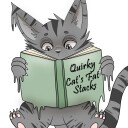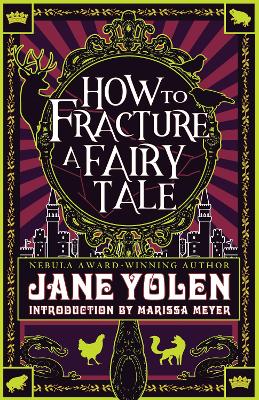
Quirky Cat
Written on Nov 11, 2018
How to Fracture a Fairy Tale is an absolutely astonishing collection from the mind of Jane Yolen. If you’re a fan of fairy tales, or reading twisted versions of them (not to say that the original versions aren’t exceptionally twisted to begin with…) then this is something you may want to look into. Yolen has mastered the art of looking at a story in a different light, breathing new life into a tale told thousands of times.
But this novel isn’t just a compilation of short stories (though I would have been very happy with that much) but also notes on the stories, and even some poetry. Not every story has an explanation or a poem, but most of them have one or the other. It really adds to the depth of the tales being told. Personally, I loved this touch as I wasn’t always able to identify the fairy tale her works were being based off (more than one of them I was not familiar with in the first place, as it turns out).
The stories and poems here vary from whimsical to disturbingly dark; leaving the reader feeling haunted or chilled. Being that these are fractured fairy tales, most of them have a darker undertone. Sometimes the elements used could be considered disturbing, but they’re all beautifully written despite that.
Snow in Summer
It’s fairly easy to guess which tale Snow in Summer is based off of. And yet Yolen still was able to make reading her tale an experience. While one would assume it’d go a certain direction (the one we’ve all become so used to) Jane Yolen put a slight spin on it, not altering the core of the tale…but making it hers and adding unexpected elements.
The Bridge’s Complaint
Warnings: Animal death
The Bridge’s Complaint is one of my favorites in this collection; if nothing else than for its utterly unique view on telling the story. Who would have ever expected to hear The Three Billy Goats Gruff told from the perspective of the bridge it was set upon? It certainly wasn’t something I expected, but I have to admit that it worked really well in this instance.
The Moon Ribbon
I was able to identify The Moon Ribbon as a retelling of Cinderella – you can see some obvious elements from it right away. But I missed the second story that was pulled into this tale, to create the unique telling. Jane Yolen mentions in the back that she also used George MacDonald’s The Princess and the Goblin as inspiration. While elements of both have been woven together here, the work is purely Yolen’s doing. You can see what she added (even without my knowing much about The Princess and the Goblin). I loved this tale. It read like a poem, and very appropriately it gave Cinderella the poetic justice I also felt it deserved (and by that I’m obviously referring to the step-mother and step-sisters).
Godmother Death
I’ll confess that I’d never heard of the tale that this one is based off – at least I don’t remember it if so. It’s a folklore called Godfather Death. So you can already see how it’s been altered to suit our writer’s needs. This is another one of my favorites from the collection. I loved the nature of Godmother Death – from her agreement to be a godmother to the way she handled her duties. It was all brilliantly done. And it wouldn’t be a true fairy tale if there wasn’t punishment for any attempt at trickery.
Happy Dens or A Day in the Wold Wolves’ Home
This one is more a collection of short stories within itself, but I love that change as well. How often do you hear of all the wolf based fairy tales being merged into one telling? (Well, conversation in this case). Never! By this point in the collection I found myself thoroughly impressed by all the unexpected elements I’ve come across. I probably shouldn’t have been surprised though, this sort of writing is exactly the reason why I’m a fan of Jane Yolen.
Here we see references and retellings of the Big Bad Wolf, The Three Little Pigs, and The Boy Who Cried Wolf. The first was my favorite of the retellings, but I don’t want to explain the reason and spoil it for everyone. Let’s just say that I really enjoyed the little reference made there.
Granny Rumple
Where Happy Dens made me smile, Granny Rumple broke my heart. It’s a retelling of sorts, though it feels too rooted in real life to be able to really say that. Essentially the story explores the concept of Rumplestiltskin being Jewish. This one broke my heart because there are times in our history where this sort of event truly would have happened. I suppose it struck too close to home, but that made it feel more real and less whimsical…but at the save time it was a terrifyingly good perspective. After all, fairy tales are meant to teach a lesson, and I certainly learned one here.
One Ox, Two Ox, Three Ox, and the Dragon King
This was another tale that I didn’t recognize, but I was okay with that. This one is based off of Chinese folklore – pulling bits and pieces from several different tales (I couldn’t tell you which ones specifically – I’m going to have to add a few compilations of folklore to my TBR pile after this).
It’s a longer story, with lots of repetition and buildup…but I like the point that’s being made here. On the whole it’s much more positive than many of the others included in this collection, and I’m sure that was intentional (in the description at the end Jane Yolen mentioned that she considers Eastern folklore to be much more positive with their dragon lore).
Brother Hart
Brother Hart is based on another Grimm tale, which I think so far have all been my favorites by Yolen. I’ve noticed that she has come back a couple of times to the Hart/stag theme, and both times I’ve loved it.
The tale is based off of Little Brother, Little Sister. Though really it shows the events that follow the original story. That makes it unique among the others so far, in that it twists the fairy tale but also carries it forward.
Sun/Flight
Right away I could tell that this one was a variation on the tale of Icarus. It is more sea based than the original (or at least it felt that way to me) but in a way it also made it feel so much more…human. So I’m happy with every change that was made here.
I think this tale might actually continue after the tale of Icarus…but I don’t want to say that for sure. In this case I feel like knowing that as a fact may change the story. At least for me I think it would have.
Slipping Sideways Through Eternity
This is another sad tale, but again it’s because it’s so heavily rooted in the real world. It’s another tale by Jane Yolen where the main character is a little Jewish girl. Here she also travels through time, but for a different reason. It’s a retelling of Elijah, though I’m not an expert in that tale either. Still, it is breathtaking and heart wrenching and absolutely worth reading.
The Foxwife
This story is focused on the legend of kitsune, and it’s one of the lores that I personally can’t get enough of. Apparently this short story had originally been printed in Year’s Best Fantasy (from 1984), something I didn’t know before (I really should start reading those yearly collections!).
I love the take of the kitsune here. Even though she isn’t the main perspective, you can almost feel her emotions and see what she’s thinking. It was beautifully written, all the more so by having an unknowing human be the main perspective.
The Faery Flag
The Faery Flag is based on a real item – it’s a flag hanging up on Dunvegan Castle on the Isle of Skye (Soctland). It isn’t much to base a tale off of, but it’s no surprise that Jane Yolen succeeded in doing just that. It’s a tale of bargaining, faery deals, lore and rules, and oddly enough, of love. This is one that is better off read than described.
One Old Man, with Seals
According to Jane Yolen, One Old Man, with Seals is based off of Proteus, the Greek shapeshifter. It’s the tale of getting older, accepting the time one has left, and enjoying it. But it feels so much richer than the way I described it. It’s beautifully written, with a slightly eerie and ethereal tone to it.
Sleeping Ugly
Just by the title you can clearly tell that this is a retelling of Sleeping Beauty. Ever since I learned the much more disturbing original tale of this one I’ve had trouble enjoying it, so it was nice to see a new perspective take the reins.
Here the princess is quite beautiful on the outside, but very ugly on the inside. Then there’s the young maiden in the woods, who is the exact opposite. Now I’ll ask you, which one of those two would you say deserves the happily ever after of her dreams?
The Undine
This one is mostly based off the original Hals Christian Andersen’s Little Mermaid, but it also has some influence in other French stories about mermaids (aka the undine). I’m using the terms mermaid and undine interchangeably here, which some people may argue with. However I believe that they have the same intent and connotation, especially in this story, so it’s okay.
It certainly has the more somber and despondent tones of the original tale; a sort of romanticized view on doomed love and the pain it can cause. However, it is from the undine’s perspective, and the prince feels like he would fit in with today’s time.
Great-Grandfather Dragon’s Tale
Great-Grandfather Dragon’s Tale is told as two stories in one. One is past tense, it’s the story the Great-Grandfather Dragon is telling, and the other is of the reaction to the little ones he’s telling it to. It’s an interesting tale, and oddly relaxing to read.
The tale itself is based off of St. George’s Dragon, and was inspired when Jane Yolen was compiling her dragon stories into a collection titled Here There Be Dragons.
Green Plague
Green Plague is a more modernized retelling of The Pied Piper of Hamelin. It’s satirical and doesn’t really look all that kindly on the townspeople, though I suppose that isn’t terribly new, is it? Here the people of Hamelin prosper from their past and the lore that they carry, only to let themselves fall into the very same mistakes all over again.
The Unicorn and the Pool
The Unicorn and the Pool blends an older unicorn and Jesus into the same character. The wise unicorn is willing to sacrifice himself to save others, even though it’s one amongst them that caused the problem to begin with.
It’s a short tale, and it is utterly heartbreaking as well. You can tell right away where the tale will lead, and there’s nothing you can do to stop it.
The Golden Balls
The Golden Balls is a retelling of The Princess and the Frog. I never read the original tale (well, either of the originals, as it turns out) so I can’t speak directly to the changes made. I will say that this one unsettled me the most. There’s implied rape, which to be fair not only fits in with the time (it could be an allegory to the arranged marriages many princesses faced) but also the brother’s cruelty for allowing (encouraging more like) it to happen.
Sister Death
Sister Death is a blend of Lilith and the Angel of Death. This is one of those stories that starts out interesting, even as you know it’s bound to break your heart. And it certainly does. Based heavily in Jewish lore, the Sister Death has to carry away countless dead children – especially during the time of the Holocaust. It’ll break your heart, I promise you that. But it is still worth reading. Sometimes the hardest tales to read are the ones that we must read.
Sule Skerry
Sule Skerry is a tale of selchies. If you’ve read any selchie lore, then you’ll know that they’re fairly famous (infamous) for finding and impregnating young maidens. Apparently they can even do so when they’re at deaths doors. Truth be told, I’m not surprised by that revelation. What made this tale fractured was the time Jane Yolen chose to base it in, and how it all played out.
Once a Good Man
Once a Good Man is based off of Jewish and Chinese tales. Here the main character, and older and quite wonderful man, has asked to see both heaven and hell so that he may be happy knowing it. The differences between two are surprisingly slight, but incredibly important to make note of.
Allerleirauh
Allerleirauh is another retelling of Cinderella. I think that makes two (so far) in this collection. However, it is very very different from others, even the first one included here. I’ll be honest with you here – I didn’t realize it was a Cinderella variant when I was reading it. I can see it now though. It’s based off of one of the three original versions of the tale (all very dark, of course). This one is fairly disturbing, and incestuous (as was the original it’s based off), so consider yourself warned.
The Gwynhfar
This one is a retelling of Arthurian legend, while also very much being commentary on the practice to marry off (aka sell off) princesses to dukes and other esteemed men. There’s no doubt left on how Jane Yolen feels of the practice, not after you’ve read this tale.
Cinder Elephant
Cinder Elephant is the third Cinderella retelling in this collection. It’s also the last Cinderella retelling included, in case you were curious. With this tale we have all three of the original versions in one fractured form or another. This was probably my second favorite of the three, and there are many reasons for that. It feels like the happy medium you’d expect between the original and the Disney version, but of course with a twist or two. The only thing that wasn’t changed was how dull the prince was (who needs a shoe to identify the woman he supposedly loves?).
Mama Gone
This one is a vampire story. It’s very straightforward, but the emotions and turmoil in it will keep you reading until the very end. You never really see a tale quite like this one. The vampire is not a wealthy count, nor do they really appear to be capable of rational thought. It’s brilliantly written, and that’s coming from a vampire snob.
The Woman Who Loved a Bear
According to Jane Yolen, The Woman Who Loved a Bear is based on Native American lore. I love that Jane Yolen pointed out that she isn’t Native American, and that she hopes she did justice to the original tale. It’s not every day you see somebody that sensitive to the original material. It’s easy to read the title and assume that the bear is an actual bear, as opposed to a person (and member of a specific tribe). This one was really well written, though I really can’t comment on the original lore and the differences between the two.
Wrestling with Angels
This one is a modern retelling of Jacob and the time he wrested an angel. I honestly never would have expected to see this tale based in New York, and yet here we are! It adds an interesting perspective to the well known tale.
For more reviews, check out Quirky Cat's Fat Stacks


